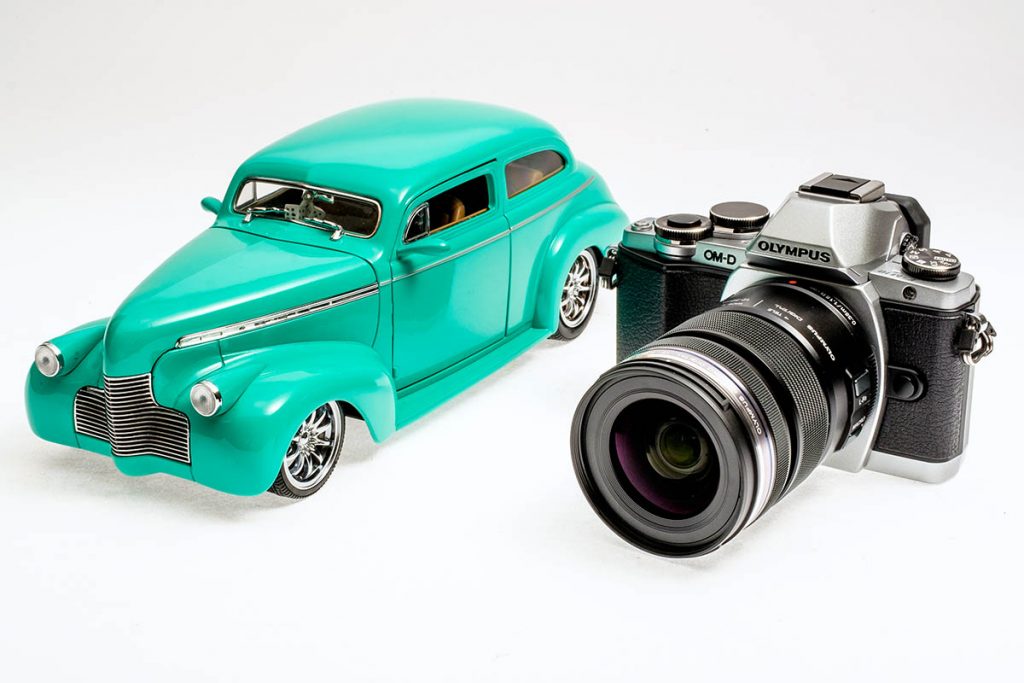In space no-one can hear you scream. The same applies to your own photographic studio if you pad the walls thickly enough. It’s not the screaming that the neighbours mind - it’s the language. I try not to make the Little Studio into an F*** stop…

But occasionally the cries can be those of delight - particularly if the planned shoot goes well. This week’s investigation of the reconditioned Olympus OM-D E-M10 was one of those times.
The two models chosen: the 90’s-style chopped ’39 Chevrolet and the Toyota Toyo-ace tray-top. The former is a 1:18 scale model with the peculiar characteristic of throwing light everywhere and the latter is a 1:64 Tomy model from Japan. The idea was to see how the 12-50mm f:3.5-6.3 EZ lens would cope with the depth of field problem and also to see if the vaunted Olympus image stabilisation system actually works.

OLYMPUS DIGITAL CAMERA
Forgive me, Burke, for the word “ actually “. It makes it sound like I doubt the claims that Olympus make. But I am from Missouri when it comes to brochure claims and until I can see it with my own eyes I am still skeptical.
The control images for the shoot were the standard studio rig of a Tokina 35mm macro and the Fujifilm X-E2 firmly attached to a studio stand - no image stabilisation available on lens or body... The Olympus was used hand-held with the IS turned on. There was a little redeeming difference between the Fujifilm and The Olympus - again because I had not figured out the RAW control of the Olympus. But it is there in plain sight and does work well with simple image editing programs so you are encouraged to use it. In the event, it only really made a little difference to the contrast and you can iron that out with a slider.

OLYMPUS DIGITAL CAMERA

The visual results were delightful - the 12mm end of the lens makes the Chevy nose loom out at the viewer, but once you rack it back to a more sensible angle of view you get a great artistic effect and increased depth of field over the Fujifilm result. This is simple optical geometry associated with a smaller sensor and shorter focal length in the Olympus.

OLYMPUS DIGITAL CAMERA
The whooping advantage of the 12-50 Olympus lens is the macro end - It is accessed though a separate switch at the side of the lens and locks it into one focal length when engaged…but the results are terrific. Look at the Toyo-Ace and look at a 10¢ piece in your pocket and ponder on it for a while.

OLYMPUS DIGITAL CAMERA
Okay, that is the Little Studio part of the shoot. Tomorrow we go out to Aphid Acres and see what the devices can do in the garden. Those of you who love botanic art and flowering beauty are advised to have smelling salts handy.
 But occasionally the cries can be those of delight - particularly if the planned shoot goes well. This week’s investigation of the reconditioned Olympus OM-D E-M10 was one of those times.
The two models chosen: the 90’s-style chopped ’39 Chevrolet and the Toyota Toyo-ace tray-top. The former is a 1:18 scale model with the peculiar characteristic of throwing light everywhere and the latter is a 1:64 Tomy model from Japan. The idea was to see how the 12-50mm f:3.5-6.3 EZ lens would cope with the depth of field problem and also to see if the vaunted Olympus image stabilisation system actually works.
But occasionally the cries can be those of delight - particularly if the planned shoot goes well. This week’s investigation of the reconditioned Olympus OM-D E-M10 was one of those times.
The two models chosen: the 90’s-style chopped ’39 Chevrolet and the Toyota Toyo-ace tray-top. The former is a 1:18 scale model with the peculiar characteristic of throwing light everywhere and the latter is a 1:64 Tomy model from Japan. The idea was to see how the 12-50mm f:3.5-6.3 EZ lens would cope with the depth of field problem and also to see if the vaunted Olympus image stabilisation system actually works.
 OLYMPUS DIGITAL CAMERA
OLYMPUS DIGITAL CAMERA OLYMPUS DIGITAL CAMERA
OLYMPUS DIGITAL CAMERA The visual results were delightful - the 12mm end of the lens makes the Chevy nose loom out at the viewer, but once you rack it back to a more sensible angle of view you get a great artistic effect and increased depth of field over the Fujifilm result. This is simple optical geometry associated with a smaller sensor and shorter focal length in the Olympus.
The visual results were delightful - the 12mm end of the lens makes the Chevy nose loom out at the viewer, but once you rack it back to a more sensible angle of view you get a great artistic effect and increased depth of field over the Fujifilm result. This is simple optical geometry associated with a smaller sensor and shorter focal length in the Olympus.
 OLYMPUS DIGITAL CAMERA
OLYMPUS DIGITAL CAMERA OLYMPUS DIGITAL CAMERA
OLYMPUS DIGITAL CAMERA